+ Open data
Open data
- Basic information
Basic information
| Entry | Database: PDB / ID: 7o9h | |||||||||
|---|---|---|---|---|---|---|---|---|---|---|
| Title | Escherichia coli FtsY in complex with pppGpp | |||||||||
 Components Components | Signal recognition particle receptor FtsY | |||||||||
 Keywords Keywords | TRANSLATION / stringent response / targeting complex / signal recognition particle / alarmones / stress | |||||||||
| Function / homology |  Function and homology information Function and homology informationSRP54, nucleotide-binding domain / Four Helix Bundle (Hemerythrin (Met), subunit A) / P-loop containing nucleotide triphosphate hydrolases / Up-down Bundle / Rossmann fold / 3-Layer(aba) Sandwich / Mainly Alpha / Alpha Beta Similarity search - Domain/homology | |||||||||
| Biological species |  | |||||||||
| Method |  X-RAY DIFFRACTION / X-RAY DIFFRACTION /  SYNCHROTRON / SYNCHROTRON /  MOLECULAR REPLACEMENT / Resolution: 2.4 Å MOLECULAR REPLACEMENT / Resolution: 2.4 Å | |||||||||
 Authors Authors | Czech, L. / Mais, C.-N. / Bange, G. | |||||||||
| Funding support |  Germany, 1items Germany, 1items
| |||||||||
 Citation Citation |  Journal: Nat Commun / Year: 2022 Journal: Nat Commun / Year: 2022Title: Inhibition of SRP-dependent protein secretion by the bacterial alarmone (p)ppGpp. Authors: Laura Czech / Christopher-Nils Mais / Hanna Kratzat / Pinku Sarmah / Pietro Giammarinaro / Sven-Andreas Freibert / Hanna Folke Esser / Joanna Musial / Otto Berninghausen / Wieland Steinchen ...Authors: Laura Czech / Christopher-Nils Mais / Hanna Kratzat / Pinku Sarmah / Pietro Giammarinaro / Sven-Andreas Freibert / Hanna Folke Esser / Joanna Musial / Otto Berninghausen / Wieland Steinchen / Roland Beckmann / Hans-Georg Koch / Gert Bange /  Abstract: The stringent response enables bacteria to respond to nutrient limitation and other stress conditions through production of the nucleotide-based second messengers ppGpp and pppGpp, collectively known ...The stringent response enables bacteria to respond to nutrient limitation and other stress conditions through production of the nucleotide-based second messengers ppGpp and pppGpp, collectively known as (p)ppGpp. Here, we report that (p)ppGpp inhibits the signal recognition particle (SRP)-dependent protein targeting pathway, which is essential for membrane protein biogenesis and protein secretion. More specifically, (p)ppGpp binds to the SRP GTPases Ffh and FtsY, and inhibits the formation of the SRP receptor-targeting complex, which is central for the coordinated binding of the translating ribosome to the SecYEG translocon. Cryo-EM analysis of SRP bound to translating ribosomes suggests that (p)ppGpp may induce a distinct conformational stabilization of the NG domain of Ffh and FtsY in Bacillus subtilis but not in E. coli. | |||||||||
| History |
|
- Structure visualization
Structure visualization
| Structure viewer | Molecule:  Molmil Molmil Jmol/JSmol Jmol/JSmol |
|---|
- Downloads & links
Downloads & links
- Download
Download
| PDBx/mmCIF format |  7o9h.cif.gz 7o9h.cif.gz | 132.1 KB | Display |  PDBx/mmCIF format PDBx/mmCIF format |
|---|---|---|---|---|
| PDB format |  pdb7o9h.ent.gz pdb7o9h.ent.gz | 100.9 KB | Display |  PDB format PDB format |
| PDBx/mmJSON format |  7o9h.json.gz 7o9h.json.gz | Tree view |  PDBx/mmJSON format PDBx/mmJSON format | |
| Others |  Other downloads Other downloads |
-Validation report
| Summary document |  7o9h_validation.pdf.gz 7o9h_validation.pdf.gz | 1.1 MB | Display |  wwPDB validaton report wwPDB validaton report |
|---|---|---|---|---|
| Full document |  7o9h_full_validation.pdf.gz 7o9h_full_validation.pdf.gz | 1.1 MB | Display | |
| Data in XML |  7o9h_validation.xml.gz 7o9h_validation.xml.gz | 24 KB | Display | |
| Data in CIF |  7o9h_validation.cif.gz 7o9h_validation.cif.gz | 33.1 KB | Display | |
| Arichive directory |  https://data.pdbj.org/pub/pdb/validation_reports/o9/7o9h https://data.pdbj.org/pub/pdb/validation_reports/o9/7o9h ftp://data.pdbj.org/pub/pdb/validation_reports/o9/7o9h ftp://data.pdbj.org/pub/pdb/validation_reports/o9/7o9h | HTTPS FTP |
-Related structure data
| Related structure data | 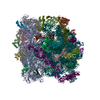 7o5bC  7o9fC  7o9gC  7o9iC  2yhsS S: Starting model for refinement C: citing same article ( |
|---|---|
| Similar structure data |
- Links
Links
- Assembly
Assembly
| Deposited unit | 
| ||||||||||
|---|---|---|---|---|---|---|---|---|---|---|---|
| 1 |
| ||||||||||
| Unit cell |
|
- Components
Components
| #1: Protein | Mass: 34295.359 Da / Num. of mol.: 2 Source method: isolated from a genetically manipulated source Source: (gene. exp.)   #2: Chemical | #3: Water | ChemComp-HOH / | Has ligand of interest | Y | |
|---|
-Experimental details
-Experiment
| Experiment | Method:  X-RAY DIFFRACTION / Number of used crystals: 1 X-RAY DIFFRACTION / Number of used crystals: 1 |
|---|
- Sample preparation
Sample preparation
| Crystal | Density Matthews: 2.72 Å3/Da / Density % sol: 54.84 % |
|---|---|
| Crystal grow | Temperature: 293 K / Method: vapor diffusion, sitting drop / pH: 7.5 Details: 8.5% isopropanol, 0.085 M HEPES pH 7.5, 17% PEG 4000, 15 % glycerol |
-Data collection
| Diffraction | Mean temperature: 100 K / Serial crystal experiment: N |
|---|---|
| Diffraction source | Source:  SYNCHROTRON / Site: SYNCHROTRON / Site:  ESRF ESRF  / Beamline: MASSIF-3 / Wavelength: 0.976253 Å / Beamline: MASSIF-3 / Wavelength: 0.976253 Å |
| Detector | Type: DECTRIS EIGER X 4M / Detector: PIXEL / Date: Sep 13, 2020 |
| Radiation | Protocol: SINGLE WAVELENGTH / Monochromatic (M) / Laue (L): M / Scattering type: x-ray |
| Radiation wavelength | Wavelength: 0.976253 Å / Relative weight: 1 |
| Reflection | Resolution: 2.4→45.35 Å / Num. obs: 161630 / % possible obs: 90.78 % / Redundancy: 6.2 % / Biso Wilson estimate: 34.12 Å2 / CC1/2: 0.993 / Net I/σ(I): 8.85 |
| Reflection shell | Resolution: 2.4→2.486 Å / Num. unique obs: 18544 / CC1/2: 0.782 |
- Processing
Processing
| Software |
| ||||||||||||||||||||||||||||||||||||||||||||||||||||||||||||||||||||||
|---|---|---|---|---|---|---|---|---|---|---|---|---|---|---|---|---|---|---|---|---|---|---|---|---|---|---|---|---|---|---|---|---|---|---|---|---|---|---|---|---|---|---|---|---|---|---|---|---|---|---|---|---|---|---|---|---|---|---|---|---|---|---|---|---|---|---|---|---|---|---|---|
| Refinement | Method to determine structure:  MOLECULAR REPLACEMENT MOLECULAR REPLACEMENTStarting model: 2YHS Resolution: 2.4→45.35 Å / SU ML: 0.33 / Cross valid method: FREE R-VALUE / σ(F): 1.36 / Stereochemistry target values: ML
| ||||||||||||||||||||||||||||||||||||||||||||||||||||||||||||||||||||||
| Solvent computation | Shrinkage radii: 0.9 Å / VDW probe radii: 1.11 Å / Solvent model: FLAT BULK SOLVENT MODEL | ||||||||||||||||||||||||||||||||||||||||||||||||||||||||||||||||||||||
| Refinement step | Cycle: LAST / Resolution: 2.4→45.35 Å
| ||||||||||||||||||||||||||||||||||||||||||||||||||||||||||||||||||||||
| Refine LS restraints |
| ||||||||||||||||||||||||||||||||||||||||||||||||||||||||||||||||||||||
| LS refinement shell |
|
 Movie
Movie Controller
Controller







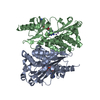
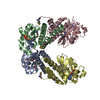
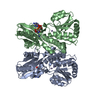
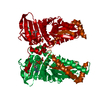
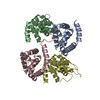
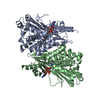
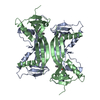
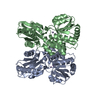
 PDBj
PDBj


